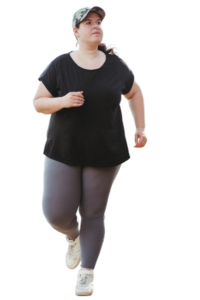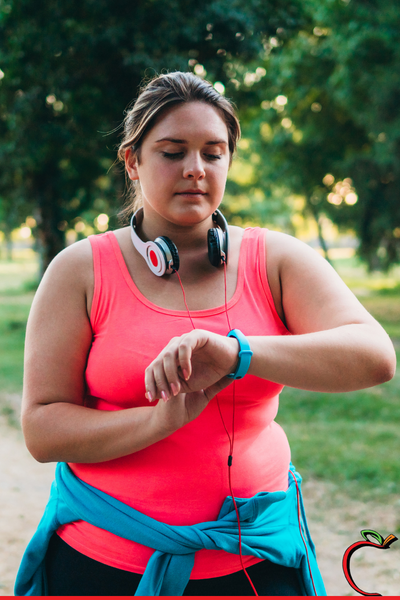Is Running Safe for People Who are Overweight?
Running is a very effective fitness option that can help reduce your risk for diabetes, heart disease, and cancers1, boost your confidence, help you achieve a healthy weight3, and manage anxiety4. Running isn’t only reserved for thin people and runners come in all shapes and sizes. Many people use running as a way to lose weight, stay lean, control anxiety, and manage their health. If your current BMI is classified as overweight or more, and you wish to start a running routine, you absolutely can — running can be doable and safe! Here’s how:
Take it Slow
If you’re a beginner runner, your muscles, tendons, and joints are being challenged in a new, unfamiliar way. Also, the more weight you are carrying around, the greater the load on your body. The impact force of running is two to three times as high as walking5, so it is healthier to start building endurance through walking first. For example, begin with 15 minutes, 3 times a week, and increase the duration after 2-3 weeks if all goes well. Eventually, depending on how strong you feel, you can gradually increase to a combination of walking and jogging. For example: 1 minute of running followed by 1 minute of walking. Repeat 3-5 times per session. When this feels easy, increase to 2 minutes of running or do more repetitions. Never underestimate how important it is to start slowly and be patient with yourself to prevent overtraining. Slow and steady really DOES win the race.
Start with a warm-up, and end with a cooldown
Warming up and cooling down is just as important as the exercise routine itself. Start any routine with a proper warm-up to prepare the body for movement, increase blood flow to the muscles, and decrease the risk of injury. A proper cool down starts the recovery process and returns to heart rate and blood pressure to normal ranges6.
 Focus on endurance, not speed
Focus on endurance, not speed
When starting your running routine, it is best to focus on light, easy runs with an intensity level of less than 75% of maximum exertion and slowly increasing to moderate intensity runs, approximately 75-80% maximum intensity. This slower pace reduces the force on your body and thus the strain on your tendons, muscles, and joints. A good rule of thumb is that If you can carry on a conversation when you run, you’re in the right range. If you are running to lose weight, this kind of light, easy run is an effective way to reach your goal because it boosts your metabolism. Try to keep your stride short to avoid overextending your legs.
Slowly increase your intensity and/or duration
The intensity of your workouts should increase slowly and gradually. Give your body time to adjust to the strain of working out. When the workout gets too easy, you can gradually increase the intensity (speed) and duration (time). A suggested schedule to build a solid base is three times a week for about 30 minutes each session. Building in rest days is vital7 & don’t forget to warm up and cool down!
Increase lean body mass
In addition to your running routine, consider adding stability exercises to strengthen your muscles to improve lean body mass and metabolism while also preventing injury. Some Nutrition HealthWorks dietitians are also Certified Personal Trainers and/or Run Coaches so can provide additional detailed guidance on how to progress your runs while also incorporating cross-training!
Nutrition is key
The right nutrition is essential to ensure that your workouts are successful and your body has the energy stores required for optimum performance. Contact our team of Registered Dietitians to develop a structured nutrition plan that is customized to your needs and preferences.
DISCLAIMER: Obtain your doctor’s clearance before beginning or adjusting your exercise routine.

Terah Starbuck
MS, RDN, CPT
Sources:
- Williams PT, Thompson PD. Walking versus running for hypertension, cholesterol, and diabetes mellitus risk reduction. Arterioscler Thromb Vasc Biol. 2013;33(5):1085-1091. doi:10.1161/ATVBAHA.112.300878
- McAuley, E., Blissmer, B., Katula, J. et al. Physical activity, self-esteem, and self-efficacy relationships in older adults: A randomized controlled trial. ann. behav. med. 22, 131 (2000). https://doi.org/10.1007/BF02895777
- Paul Poirier, Jean-Pierre Després, EXERCISE IN WEIGHT MANAGEMENT OF OBESITY, Cardiology Clinics, Volume 19, Issue 3, 2001, Pages 459-470, ISSN 0733-8651, https://doi.org/10.1016/S0733-8651(05)70229-0.
- Carek PJ, Laibstain SE, Carek SM. Exercise for the Treatment of Depression and Anxiety. The International Journal of Psychiatry in Medicine. 2011;41(1):15-28. doi:10.2190/PM.41.1.c
- Swain DP, Kelleran KJ, Graves MS, Morrison S. Impact Forces of Walking and Running at the Same Intensity. J Strength Cond Res. 2016;30(4):1042-1049. doi:10.1519/JSC.0000000000001185
- The right way to warm up and cool down. Mayo Clinic. https://www.mayoclinic.org/healthy-lifestyle/fitness/in-depth/exercise/art-20045517. Published October 6, 2021. Accessed December 13, 2021.
- Vincent, H.K. and Vincent, K.R. (2013), Considerations for Initiating and Progressing Running Programs in Obese Individuals. PM&R, 5: 513-519. https://doi.org/10.1016/j.pmrj.2013.03.008




I weigh 218 at 5.6 when I was 46. Started walking on a treadmill a quarter of a mile. Twice a day. Thought I would died. Got up to 1mile in the morning and one in the afternoon. Finally got up 3 in the morning and 3 in the afternoon. I told myself I could get through faster if I ran. I finally got up to ten mile a day. I lost 69 lbs. From April 97 to October 97. I ran 3 marathon and 1 half and a couple 5 k. Between Oct. and March 98. I never thought I could do this. I ran mine last marathon in 2020 at Disney. I am 75 year old and still running but not marathon. Just 12k and shorter now. Don’t let anyone tell you, you can’t run. Only you can say that.